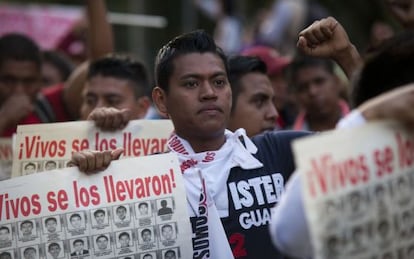Thousands take to the streets over missing Mexican students
Parents of disappeared youngsters lead massive demonstration in Mexico City


The third major demonstration over the 43 Ayotzinapa students who disappeared in the town of Iguala on September 26 began just after 4pm on Thursday at Los Pinos presidential palace. Three hours later, the peaceful march arrived at the Zócalo, the city’s symbolic main square, after crossing the major Paseo de la Reforma thoroughfare. Organizers put the number of demonstrators at around 100,000, while city officials said it was 20,000.
“Why-why-why / Why do they kill us/ If we are the hope / of Latin America?,” the students chanted. “Ayotzi is alive, Ayotzi is alive, Ayotzi is alive and so the struggle goes on and on!” An overwhelming number of the demonstrators were students. Yet, the more modest presence of regular citizens – workers, civil servants, liberal professionals, families, and those from other sectors – added to the growing momentum of the student movement and, together, could help the protests gain critical mass. There is massive and noticeable indignation but, for now, the dams have not burst.
“This case has stirred people’s conscience, but the response is not enough yet,” said Ilda Rosales, a 52-year-old teacher who came to the march with her daughter, Silvana, a film student. A large white poster behind them says “the state is dead,” in big black letters. Silvana said the youths carrying the sign were members of a “contingent” from the art schools – a word that speaks more of martial discipline than social rebellion. But that is how massive demonstrations are organized in Mexico – through contingents. Her mother said more people of her generation need to join the movement and that she believes one of the reasons why they have not is, in large part, because television, the most influential medium in the country, broadcasts “a message of conformism and passivity.”
“Here we are, fighting. Ayotzinapa is opening many people’s eyes,” said Ana, a 16-year-old studying industrial processing techniques at Instituto Politécnico, a public center with a rebellious history, as demonstrated in October when it took part in a series of marches against government education reforms, forcing Interior Secretary Miguel Ángel Osorio Chong to come down from his office to hear their demands.
Ana is standing to the right of a young woman holding a small poster that reads: “We are still standing up for the blood of our comrades.”
The marches are not going through political party channels. The Iguala case took place in Guerrero, a state led by the leftist Party of the Democratic Revolution (PRD) in a country governed by the centrist Institutional Revolutionary Party (PRI) – a situation that strengthened the opinion among the general public that the corruption afflicting the nation is rooted in every party.
Here we are, fighting. Ayotzinapa is opening people’s eyes” Ana, 16, student
Students from Mexico’s largest university, the Universidad Nacional Autónoma de México (UNAM), led the march, followed by Instituto Politécnico, rural teachers’ colleges and Universidad Iberoamericana, a prestigious private establishment. These colleges have decided to cancel classes from Wednesday to Friday. Civic organizations, unions, artist collectives and key members of the Church also joined in.
The marchers arrived at the Zócalo at around 7pm, where they talked to relatives of the missing students who come and go between the teachers’ college in Ayotzinapa, where the youngsters studied, and the capital in order to support the demonstrations. Eight hours of walking – there and back – in order to make sure Mexico does not lose sight of this tragedy.
Víctor Alfonso, the 16-year-old brother of missing student teacher Jesús Govany Rodríguez Tlatempa, was sitting behind the main platform. “I feel a lot of bitterness,” he says. “Especially toward President Abarca [the former Iguala mayor who was recently arrested over the disappearances] “Sometimes I feel sad because I don’t have my brother with me. I want to go look for him. Or kill the one who did this to my brother.”
Translation: Dyane Jean François
Tu suscripción se está usando en otro dispositivo
¿Quieres añadir otro usuario a tu suscripción?
Si continúas leyendo en este dispositivo, no se podrá leer en el otro.
FlechaTu suscripción se está usando en otro dispositivo y solo puedes acceder a EL PAÍS desde un dispositivo a la vez.
Si quieres compartir tu cuenta, cambia tu suscripción a la modalidad Premium, así podrás añadir otro usuario. Cada uno accederá con su propia cuenta de email, lo que os permitirá personalizar vuestra experiencia en EL PAÍS.
¿Tienes una suscripción de empresa? Accede aquí para contratar más cuentas.
En el caso de no saber quién está usando tu cuenta, te recomendamos cambiar tu contraseña aquí.
Si decides continuar compartiendo tu cuenta, este mensaje se mostrará en tu dispositivo y en el de la otra persona que está usando tu cuenta de forma indefinida, afectando a tu experiencia de lectura. Puedes consultar aquí los términos y condiciones de la suscripción digital.
Últimas noticias
The complicated life of Francesca Albanese: A rising figure in Italy but barred from every bank by Trump’s sanctions
From digital curfews to blocking apps: How technology experts protect their children online
Why the price of coffee has skyrocketed: from Brazilian plantations to specialty coffee houses
Confined to a Cuban hospital: When electricity is a matter of life or death
Most viewed
- Pablo Escobar’s hippos: A serious environmental problem, 40 years on
- Why we lost the habit of sleeping in two segments and how that changed our sense of time
- Trump’s obsession with putting his name on everything is unprecedented in the United States
- Charles Dubouloz, mountaineering star, retires at 36 with a farewell tour inspired by Walter Bonatti
- The Florida Keys tourist paradise is besieged by immigration agents: ‘We’ve never seen anything like this’








































